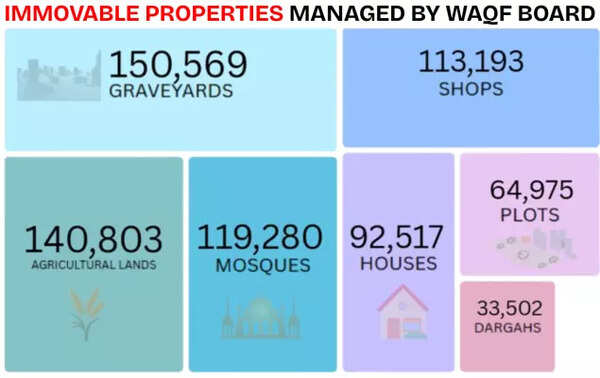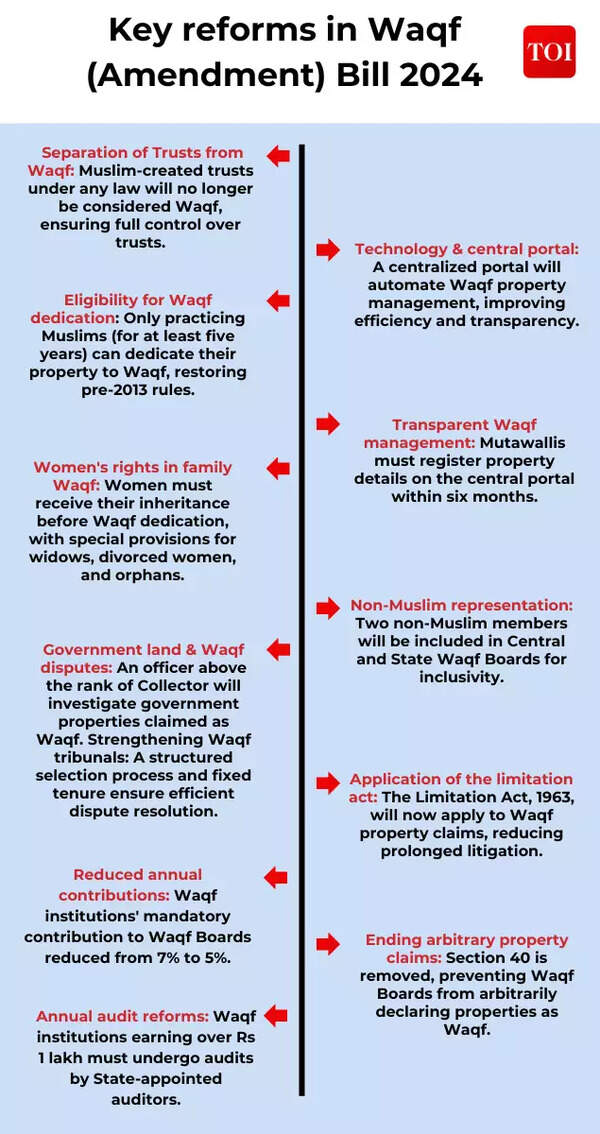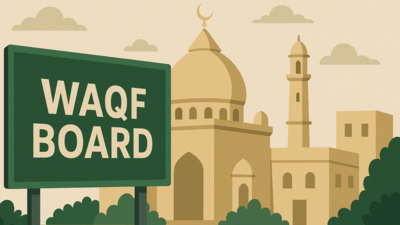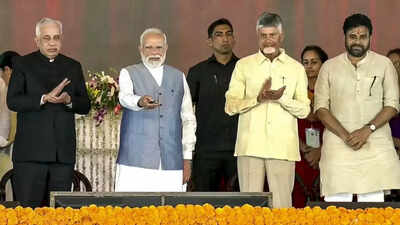In 10 big numbers – Waqf and its properties in India | India News

NEW DELHI: The Lok Sabha on Wednesday saw a heated debate as Bharatiya Janata Party-led central government and the opposition clashed over the Waqf (Amendment) Bill, tabled by minority affairs minister Kiren Rijiju.
Congress leader Gaurav Gogoi criticised the proposed changes, calling them an attack on the Constitution’s basic structure. He accused the government of diluting constitutional safeguards, defaming minorities, and dividing society.
Defending the amendments, BJP leader Ravi Shankar Prasad asserted they were necessary to prevent misuse and illegal occupation. He claimed many Waqf lands were vacant or being looted, requiring government intervention for regulation.
Waqf Amendment Bill in Parliament – Live Updates
Waqf refers to assets set aside solely for religious or charitable purposes under Islamic law, with any other use or sale of the property being forbidden.
The Waqf properties in India constitute a vast network of religious, commercial, and agricultural assets. According to the Waqf Assets Management System of India, the country has 8,72,324 immovable Waqf properties, making it one of the largest repositories of religious and community-owned land in the world.
Graveyards account for 1,50,516 properties (17%), while mosques make up 1,19,200 properties (14%). Commercial establishments such as shops (1,13,187) and houses (92,505) play an economic role, while agricultural land comprises 1,40,784 properties (16%). Religious sites like dargahs and mazars total 33,492 properties.
Waqf and its properties in 10 numbers
- Total Waqf properties: India has a staggering 8,72,324 immovable Waqf properties spread across different states and union territories.
- Dominance of graveyards: Graveyards make up 1,50,569 properties, accounting for 17% of all Waqf properties, the highest for any single category.
- Mosques hold a major share: About 1,19,200 Waqf properties are mosques, constituting 14% of the total holdings.
- Commercial establishments: Shops and houses under Waqf ownership number 1,13,187 and 92,505, respectively, showing significant economic utilisation.
- Agricultural land share: With 1,40,784 agricultural properties, Waqf plays a crucial role in landholding patterns, accounting for 16% of total properties.
- Dargahs, mazars, and makbaras: Religious sites under Waqf, including dargahs and mazars, amount to 33,492 properties.
- UP has most properties: Uttar Pradesh has the highest number of Waqf properties, 2,32,547, which makes up 27% of the national total.
- Other high-property states: Other states with significant Waqf assets include West Bengal (80,480), Punjab (75,965), Tamil Nadu (66,092), and Karnataka (62,830). Gujarat (39,940), Telangana (45,682), and Kerala (53,282) have relatively fewer properties. These include plots (64,724), ashoorkhanas (17,719), madrasas (14,008), and 1,26,189 other properties.
- Diverse usage: Besides religious sites, Waqf properties also include 64,724 plots, 17,719 ashoorkhanas, 14,008 madarsas, and 1,26,189 properties in other categories.
- Overall distribution: The states with the lowest Waqf property numbers include Gujarat (39,940), Telangana (45,682), and Kerala (53,282).
The proposed amendments introduce stricter criteria for Waqf declarations. Only practising Muslims for at least five years can dedicate property to Waqf, reverting to pre-2013 rules. Women must receive their rightful inheritance before any Waqf declaration, with provisions to safeguard widows, divorced women, and orphans.

Challenges and reforms in Waqf board management
The Waqf Board has digitised 330,000 records to improve transparency, but several challenges persist. Concerns have been raised over governance, mismanagement, and legal disputes surrounding Waqf properties.
One major issue is the irrevocable nature of Waqf properties, leading to prolonged legal battles. Courts have questioned claims over lands, such as two islands in Bet Dwarka, highlighting ambiguities in ownership. Encroachments, fraudulent registrations, and a lack of coordination with revenue authorities further complicate matters.

There is also criticism of the Waqf Act, 1995, particularly regarding the lack of judicial oversight. Tribunal decisions cannot be challenged in higher courts, raising concerns about accountability. Additionally, delays in property surveys—especially in states like Gujarat and Uttarakhand—have hindered effective management.
Cases of misuse have also surfaced, with Section 40 of the Waqf Act allegedly used to claim properties without due process. This has led to disputes and unrest in communities. In Tamil Nadu, for instance, an entire village was controversially claimed as Waqf land, leaving residents struggling to assert ownership.
To address these issues, the Ministry of Minority Affairs has initiated reforms, consulting stakeholders and examining international practices in countries like Saudi Arabia and Turkey. Key proposals include restructuring tribunals, improving property registration processes, and enforcing stricter accountability measures for Waqf Boards and Mutawallis.






